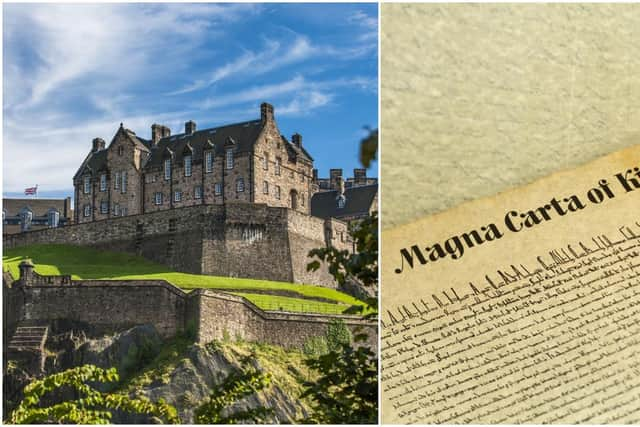Edinburgh Castle Magna Carta: what is article 61 of charter - and why protesters 'seized' landmark under it
and live on Freeview channel 276
A group of protesters claim they “seized” Edinburgh Castle on Tuesday (17 August) evening, under Magna Carta.
One man has been arrested and a police officer was injured, authorities say, after the group said they were “taking power back” at the historic site.
Advertisement
Hide AdAdvertisement
Hide AdPolice were called to the scene at around 5pm yesterday and members of the public were evacuated when the protesters entered the castle grounds without tickets.


So, what happened at Edinburgh Castle, what’s Magna Carta and what’s the meaning of Article 61?
Here’s everything you need to know.
What happened at Edinburgh Castle?
The protesters entered the Capital’s landmark on Tuesday evening, claiming to have “seized” the castle and citing Article 61 of Magna Carta.
Footage posted on social media showed a group of people gathered at the entrance to the castle saying they were there to “take power back”.
Advertisement
Hide AdAdvertisement
Hide AdA 13-minute Facebook Live video showed a woman claiming the castle “belongs to the people”, adding that the people of Scotland have been “lied to all our lives”.
She said the demonstrators had “taken the castle back” in an attempt to “restore the rule of law”.
A man added: “Treason’s been going on for that long now, we can’t sit back and let everybody perish under the stupid legislation and fraudulent government tyranny, so let’s just take it all back, not just the castle.”
The video showed a female protester telling police officers when they arrived that they were seizing the castle under Article 61 of the ancient royal charter.
Advertisement
Hide AdAdvertisement
Hide AdEdinburgh Fringe: 10 of the best places to visit and things to do during Edinburgh's Fringe Festival
What is Magna Carta?
Magna Carta, Latin for “great charter”, is a royal charter drawn up in 1215 following disputes between King John and a group of rebel barons.
The charter was intended to limit the power of the reigning monarch and give the 25 barons certain rights.
Its original version granted the barons power to “assail” the monarch and “seek redress”, but these powers were not extended to the wider population.
Advertisement
Hide AdAdvertisement
Hide AdThis first Magna Carta was declared null and void by the Pope on the grounds that it interfered with the king’s authority.
It was then reissued in various forms, with the 1225 version forming the basis of common law we use today, although much of it has since been repealed.
Magna Carta has never applied in Scotland as it predates the Act of Union.
Advertisement
Hide AdAdvertisement
Hide AdWhat is Article 61?
Article 61, or Clause 61, of Magna Carta is the specific part of the charter that some people believe allows them to lawfully dissent.
Known as the “security clause”, it gave the barons the right to form a committee who could take action against the king if he failed to honour the freedoms given to them by the charter.
Article 61 set out rules for 25 specific barons and did not allow the general public to rebel against the king.
Part of the clause states: “If we, our chief justice, our officials, or any of our servants offend in any respect against any man, or transgress any of the articles of the peace or of this security, and the offence is made known to four of the said twenty-five barons, they shall come to us - or in our absence from the kingdom to the chief justice - to declare it and claim immediate redress.”
Advertisement
Hide AdAdvertisement
Hide AdIt also refers to the seizing of “castles, lands and possessions” until redress has been secured.
The original 1215 Magna Carta had 63 clauses, but only four of them are still relevant today, and Article 61 is not one of them.
It was omitted from the following versions of the charter and was never incorporated into English statutory law.
It was also never intended to be used by the general population to rebel.
